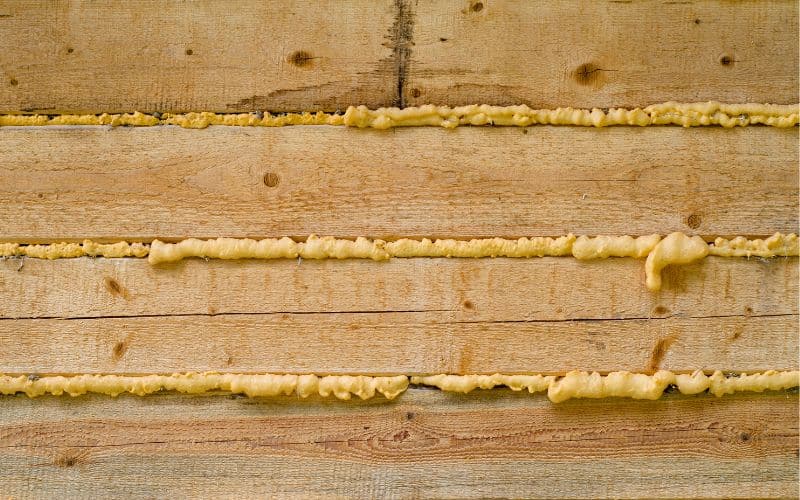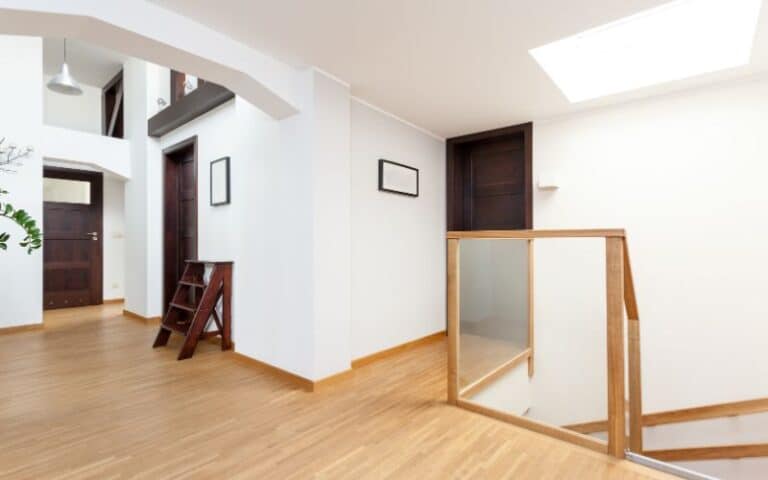Regardless of what room in your house has more traffic, the floors have the most because we’re always walking on them to get across.
So, it’s easier to notice unusual signs, such as squeaks or uneven flooring. If you do, you’re most likely dealing with a subfloor problem.
When your subfloor has gaps, it reflects on your flooring and can cause saginess. But there are practical methods to handle them.
To begin, you should first identify the cause of the gap in the subfloor & fix them. It may be leaks or lack of ventilation. Afterward, fill the gaps using wood fillers, caulk, or expanding foam. But most importantly, remember that you can’t fill all the gaps. At some point, you’ll need to replace the subfloor to maintain your floor’s structural integrity.
Are you tired of dealing with squeaky floors and uneven surfaces? Join us as we explore the world of subfloor and gap filling.
By the end of this article, you’ll learn effective methods to deal with these gaps and when to let go.
Ready for a Flooring Quiz?
6 Effective Methods for Filling Gaps in Subfloors

As we mentioned earlier, you should tackle the cause of those unusual gaps before filling gaps in subfloors.
Don’t worry; we’ll also mention that. But let’s answer the most important question: six effective methods.
#1. Using Wood Fillers
Although you can use other materials as fillers, wood is preferred and works well for small gaps. Additionally, it’s best to do this before caulking.
You can use wood strips or the conventional putty-like one and then sand it afterward. It also comes in different colors to align with your existing floor.
#2. Caulk
Caulking gaps in subfloors is another effective solution, especially since it works well for areas with movements and expansions.
If you’re having moisture problems with your subfloor, this option is the best, and you can opt for silicone caulk.
#3. Reset the Subfloor/Floorboards
Often, improper subfloor arrangement is the primary cause of gaps or floor unevenness.
This problem occurs because some people make common subfloor mistakes like nailing the boards without gaps or using incorrect spacings.
It’s always best to leave a 1/8-inch space to allow them to expand without pressure.
#4. Plywood Patches
These patches are advisable for gaps that fillers or caulks can’t handle. To begin, cut a plywood piece and ensure it aligns with the subfloor gap’s measurement.
Then fasten it with screws or nails for a sturdy and durable subfloor.
#5. Floor Adhesive
Most old houses replace subfloors with floorboards. Regardless of whichever support system you use, if they have gaps, floor adhesives are handy.
Apply them directly into the gaps and clean any excess.
#6. Expansion Foam
As the name implies, this foam expands to fill the gap in subfloors and supplies insulation and soundproofing.
This method is effective and mostly used in regions with notable temperature disparity.
Note: You can use these methods separately or combine them for a long-lasting solution depending on the severity of the subfloor gaps.
But assess the situation beforehand to make the best decision.
#7. Causes of Gaps in Subfloors
Subfloor gaps are common and can influence your flooring’s stability. We’ll be mentioning some reasons this happens below.
- It may arise due to settlement over time, which causes the subfloor to shift, thus creating gaps. It’s also a natural occurrence.
- Structural movement in buildings due to earthquakes, foundation issues, or expansion due to temperature changes
- Poor installation resulting from inaccurate measurements, poor fastening, and incorrect use of subfloor adhesive
- Moisture issues due to humidity and leaks
- Age and wear
- Failure to acclimatize subfloors before installation
- Not testing the subfloors before finishing to check for any unusual sounds
- Using the wrong nails
Best Methods for Filling Large Gaps in the Subfloor
The gap difference in subfloors ultimately influences the recommended solutions and requires something more to ensure it works.
Hence, we’ve identified the five best methods to handle this problem.
#1. Move the Subfloors
If the gap is too big, try moving the boards and placing them next to each other to see how much space remains. If it’s above the recommended gap, use a filler.
#2. Self-leveling Compound
These compounds work best for larger gaps and are a liquid mixture you can pour into the gaps, which levels over time to form a smooth surface.
You can also use a cement-based compound to achieve this.
#3. Plywood Patches
The plywood patches we mentioned earlier are an effective way of filling large subfloor gaps. Measure the gap, cut the plywood accordingly, and securely fasten it to the subfloor.
#4. Use Construction Adhesives
Subflooring adhesives are construction adhesives that work well for that purpose.
You must apply them to the gap’s edges and press a wood piece or plywood into the adhesive to create a strong bond.
#5. Backer Rod and Caulk
Backer roads are flexible foam rods that one can fix inside a large gap for support. After inserting it, apply caulk over the remaining gap.
#6. Replace the Subfloors
The final method is to change the subfloors. You can only fix so much; when you notice the gap is too large or damaged, it’s best to replace it.
The table below highlights the materials you can use to solve gaps in subfloors, their properties, advantages, and disadvantages.
| Material | Properties | Advantages | Disadvantages | Recommended Usage |
|---|---|---|---|---|
| Wood filler. | Made of wood fibers/binders. | Dries hard, sandable, easy to use. | Shrinks and isn’t for large gaps. | Small gaps in wood subfloors. |
| Latex caulk. | Made of latex. | Easy to use and paintable. | It isn’t for large gaps and cracks. | Small gaps in many subfloors. |
| Epoxy resin. | A 2-part mixture that hardens. | Strong & long-lasting. | Pricey & requires a skillful application. | Large gaps in many subfloors. |
| Self-leveling compound. | Cement-based mixture. | It offers a smooth & level surface. | Longer drying time. | Large gaps in concrete subfloors. |
| Foam insulation | Expanding foam | It offers insulation and is easy to use | It may expand too much | Small/medium gaps in subfloors |
How Wide a Subfloor Gap Should Not Be Filled?
It’s vital to address the gap issues in your subflooring before planning on fixing them because, most times, they don’t need fixing.
A ½ inch gap is the limit for subfloors; you need a replacement if you can’t fill the gap to that size.
Below, we’ll explore the recommended guidelines for determining how wide a subfloor gap should be before filling.
We’ll also discuss four gap types and the general rule of thumb before filling them.
#1. Less than ⅛ Inch
Gaps less than this in wish are conventionally allowed and don’t require filling. Such spaces are necessary to allow for natural expansion and contraction.
#2. ⅛ -¼ Inch
Gaps under this range may not always require filling precisely if the subfloor is wooden (plywood) or comprises oriented strand board.
Such materials are elastic and can accommodate minor gaps without reflecting them in squeakiness or unevenness.
#3. ¼-½ Inch
You should evaluate gaps within this range case by case. In most cases, you’ll need a filling if you notice that the gap can compromise the subfloor’s integrity.
But if it’s still solid and stable, you may not need to do a filling.
#4. Above ½ Inch
Gaps wider than half an inch are generally risky, and you should fix them immediately. Such subfloor gaps can result in structural concerns such as sagging or uneven flooring.
Filling these gaps with the appropriate materials, such as self-leveling compound or shims, is advisable to guarantee a stable and level subfloor.
Note: Refer to the table above to understand which filling material suits your subfloor type. It will give you a clearer understanding of how it works.
What Is the Best Way to Fill Gaps Between Walls and Subfloors?
Temperature changes and floor expansion can often form a gap between walls and the floor.
But the good news is that you can easily solve this issue using the most popular option: a flexible sealant or caulk.
This caulk could be silicone or acrylic, depending on the moisture issue in your home or floors.
Moreover, they’re easy to use and can prevent further moisture and, to some extent, mold.
You can use silicone caulk to prevent moisture from seeping through, as it does an airtight job. It has a clear color.
But if you need a caulk of a similar color to your wall, latex caulk is the best option.
However, it doesn’t offer water sealant features like silicone, so use it when moisture isn’t constant.
#1. Silicone Sealant
Let’s discuss some advantages of silicone caulk over latex and how to apply it.
It has stronger adhesion properties, sticking well to both walls and subfloors, forming a durable bond.
In addition, silicone sealant is flexible and can expand or contract with any temperature difference without cracking.
Silicone sealant is also moisture-resistant, making it a great choice for humid areas such as bathrooms, kitchens, or laundry rooms.
Furthermore, they have various colors, so you can use them in moisture-prone areas with matching colors.
However, before applying silicone sealant, it’s vital to clean the surfaces thoroughly. Scrape off the previous caulk in the gap if it’s cracked.
It’s best to use 180-grit sandpaper if the parts of the cracked caulk prove difficult. T
hen, vacuum any debris and scrub the gap well with water and bleach/rubbing alcohol solution.
Finally, use a dry rag to run through the area and allow it to dry well. Another option for filling gaps between walls and subfloors is using expanding foams.
This material works well for small to medium gaps while providing excellent insulation features.
But remember that it may get messy, so leave it to an expert if it proves challenging, or carefully follow the guide.
Lastly, for a more conventional method, you can use wood strips or shims to fill the gaps.
Cut the wood into small sizes and neatly insert them into the gaps to provide a secure fill.






